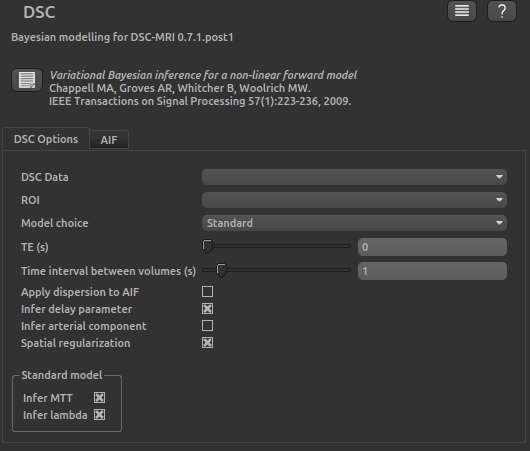DSC modelling widget user interface¶

DSC options¶
DSC datais used to select the data set containing the 4D DSC time seriesROIis used to select the region of interest data setModel choiceselects the model to be used for the inference. See The DSC Vascular Model for a description of the models available.TEis the echo time of the acquisitionTime interval between volumesshould be given in seconds. In some cases this may not be fixed as part of the acquisition protocol, but instead a series of volumes acquired, each with the time at which it was acquired. In this case you must determine a sensible fixed time difference to use, for example by dividing the total acquisition time by the number of volumes acquired.- If
Apply dispersion to AIFis selected, the model is modified to account for dispersion of the tracer within the blood during transit.- If
Infer delay parameteris selected, the arrival time of the tracer in each voxel is estimated (recommended).- If
Infer arterial componentis selected, contamination of the DSC signal by tracer in arteries is included in the model.- If
Spatial regularizationis selected, adaptive spatial smoothing on the output parameter maps is performed using a Bayesian framework where the spatial variability of the parameter is inferred from the data (recommended).
Standard model options¶
- If
Infer MTTis selected the mean transit time of the tracer is estimated
CPI model options¶
Number of control pointsselects the number of evenly spaced control points that will be used to model the residue function.Infer control point time positioncan be used to allow the control points to move their temporal position rather than being fixed in their original evenly spaced position. This may enable an accurate residue curve with fewer control points, but can also lead to numerical instability.